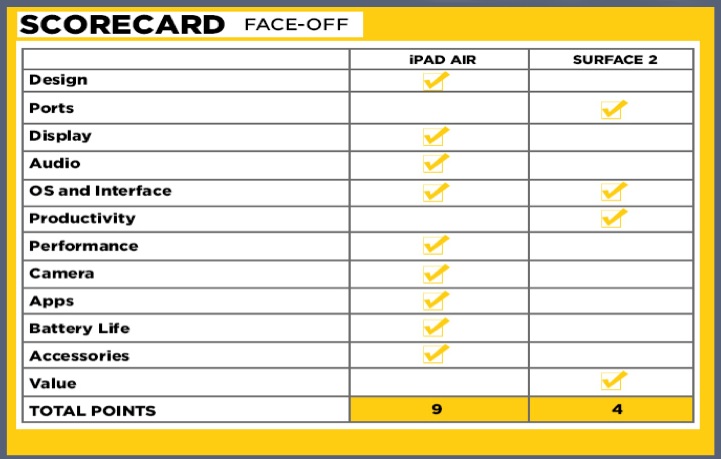Articles
| Name | Author |
|---|
EFB Tablet Strategy: Apple iPad vs Microsoft Surface
Author: Hank Putek Jr., 777 International Pilot & Training Committee Member, and Brian C. Tighe, Captain 767 & 757 and Deputy Chairman Training Committee, Allied Pilots Association
SubscribeEFB Tablet Strategy: Apple iPad vs Microsoft Surface
The current generation of tablet computers have significantly more processing power and communications capability than their predecessors. Moore’s Law suggests that this will continue for some time to come.
Early adopters of Apple iPad hardware are now finding out that the processor and RAM specifications of the early models are not up to the demands of the current application developers, since the third party developers do not develop for ‘old hardware’
BACKGROUND FROM THE AUTHORS
The Allied Pilots Association (APA) partnered with the American Airlines (AA) Flight Department to create, implement, and gain regulatory approval for electronic flight bags at American Airlines. This project was not management driven, rather, this was a pilot initiative. The pilots designed the program and American Airlines (AA) management approved the effort because they saw significant value with system-wide implementation and a low up-front cost tablet computer.
That unique partnership between APA and the AA Flight Department produced a program that pilots wanted to use. So far, this system designed by pilots for pilots, has been deployed on COTS tablet EFBs to about 9,500 AA pilots. Following AA’s merger with US Airways, the New AA will eventually deploy approximately 13,000+ iPad’s under the company’s new Single Operating Certificate.
CHOOSING FROM TWO OPTIONS
Two of the leading tablets in the mobile device sector are the Microsoft Surface 2 and the Apple iPad Air. Both have specific advantages and disadvantages when being used on the flight deck, which makes a comparison between the two inevitable. At AA, the pilots chose the iPad for many reasons, not the least of which was form factor and availability of specific and desired applications.


WHAT TO CONSIDER IN TABLET EFBS — FUNCTIONALITY VS VALUE
There are, however, a few primary considerations when selecting a tablet computer for electronic flight bag purposes. On the operational side, software maintenance can be an expensive issue, especially for Windows operating systems. If you are trying to save costs, you don’t really want the extra overhead required for maintaining software programs – you just want them to work!
Since Apple iPad’s can successfully achieve about 70 to 75% of the tasks a Class 3 device can manage for less than a tenth of that cost, can you imagine how hard it is to make a successful Class 3 implementation argument to airline finance management?
On the operational side, software maintenance can be an expensive issue, especially for Windows operating systems. If you are trying to save money, you don’t really want the extra overhead required for maintaining software programs – you just want them to work! That ratio of ‘functionality vs value’ will no doubt change in the future with the full implementation of ADS-B In/Out. ITP operations and the regulator’s requirement for certified hardware and software will drive the next flight deck computer market. With current low costs of tablet computer operations, airlines are anxious to implement fast ROI EFB projects that make flight operations more efficient.

Apple states the iPad battery is good for three to four years before it will not recharge fully to 100%, and with that in mind, the FAA says that you need to have a “mandatory refresh cycle” for such COTS hardware. This is an important consideration because it could cost $3 million to refresh a large airline with 13,000 or more users.
CONNECTIVITY COSTS
As all operators move to a paperless flight deck, connectivity will be a key for EFB flight operations. Since connectivity can prove to be expensive, purchasers need to conduct cost analyses on the benefits of such features. Whether they use Wi-Fi or cellular cards now, operators should be prepared to embrace new connectivity systems, even if they are unfamiliar with them.
Some IT Departments didn’t think that the iPad would be compatible with the connectivity of their Windows based enterprise IT systems (mainly because some airline IT departments are strictly a Microsoft-based operation). So, IT department heads have to change their mentality, and get through a lot of ancestral worship to allow iPad’s to function in both their IT system and company networks as well as on the flight deck. Apple’s Enterprise IT functionality allows the iPad unit to easily fit into the Microsoft Enterprise network and server system, and of course, the Surface provides a seamless fit when it connects to large WIN IT enterprise computing platforms and networks.
SOME PRIMARY CONSIDERATIONS
There are a number of desired EFB functions that are ‘desired and required’ that can make a big difference.
- What functionality do you desire?
- What functionality is required?
- Do you need a performance calculator, or do pilots get performance data from ACARS?
If a performance calculator is considered a flight critical application, then one must consider if the needed application will run better on the Surface or the iPad. Most aviation-computing experts consider it important that no flight critical data or information is contained on a non-installed (new FAA terminology) EFB that the pilot carries in his personal flight kit. Unfortunately for most operators, non-installed devices are the least expensive way to acquire and operate EFB’s, so keeping flight critical data off of these devices may defeat the purpose of purchasing such a device.
COMPUTING SECURITY IN THE SKY
Protection of both hardware and data is significantly important. Which device is easier and cheaper to keep secure? Companies pay people millions of dollars to find vulnerabilities in their software and to protect their data. Fortunately, theft of EFB hardware seems to be a non-issue because many major airlines have implemented Mobile Device Management (MDM) applications that can put electronic location rings around EFB’s, and if they are lost or stolen, the tablets can be erased and locked down, basically ‘bricking’ the unit.
Beyond that, there is also the consideration of the theft of company and personal data. Depending on how deep you let your employees into your company network, they potentially could be walking around with company sensitive data on their device. This, obviously, isn’t good, especially if the employee lost the unit, but didn’t realize it for a lengthy period of time, which can happen with pilots’ schedules.
HARDWARE CONSIDERATIONS
One very serious hardware issue is the use of lithium batteries. The FAA gets quite concerned about allowing operators to plug an iPad or a Surface into flight deck power to recharge.
SHIP’S POWER
Testing of the ship’s power has been undertaken to ensure the aircraft power output meets the exact power requirement of the tablet. Originally the FAA stated that if there was any variance in the ship’s power to the charging power requirement, then pilots wouldn’t be allowed to charge COTS tablets on the flight deck, because the regulator did not want to have an overcharge/battery fire event on a lithium battery in the cockpit. However, as the FAA has extensively tested various fleets (including 400hz output), they seem to have now lightened up a bit, on this issue. Both the iPad and the Surface are equal in this category, each requiring similar power requirements for charging.
PRODUCT GENERATION
Product maturity is also a factor in the tablet computer implementation decision making process. Apple says that the latest iPad is fifth generation, while Microsoft’s Surface, in stark contrast, is only on it’s second generation.
PRODUCT DESIGN
Both pilots and design engineers warn that the flight deck can be an unfriendly and hostile environment for fragile tablet designs. Testing has shown that the Surface is more fragile than the iPad — when dropped from a height of 3 feet. In a similar test, the iPad survives unless it lands directly on one of it’s four corners, in which case the glass will crack and web. The iPad’s advantage in this category is important if the device is intended to be removable. If the device is “permanently mounted,” they are equal.
MOBILE DEVICE DATA MANAGEMENT
Generally speaking, third party application developers create MDM applications for iOS, but in reality, third-party developers cannot build any MDM application that operates outside of Apple’s own locked down specification. Apple controls all the MDM functionality, and developers create apps around those parameters. Apple also provides a free utility for mobile device management. This allows airline IT departments to create their own MDM for their own devices, which could save significant dollars over having to get outside contractors to create and administer a MDM system.
On the Microsoft Surface, there are a large number of third party MDM providers and the Windows 8.1 OS can have its levels of MDM controlled to the parameter and specifications that the customer wants. In that respect, Windows 8.1 OS has a much better, and wider ranging MDM capability, and is much easier to customize to the operator’s requirements.
PRIVACY EXPECTATIONS
Privacy concerns are big deal for all users of mobile devices. Pilots are especially suspicious of airline management intrusion on their personal lives. The Allied Pilots Association is particularly against its pilots using company issued devices for any personal purposes.
APA publicly states that the company-issued device should be used for company business only. If you want to listen to music, take pictures or surf the web, they advise bringing another personally owned device. There is however one exception where division of information between company issued devices, and personal devices makes no difference at all: an accident or incident.
Recently a National Transportation Safety Board report from the 2013 UPS A300 crash included all data the investigators found on both the pilots’ company issued iPads and the pilots’ personal computers and phones. The investigators downloaded all the information, and then made the content public. The moral of the story is: if you have an accident or incident, you have no privacy..
EFB ACQUISITION PROBLEMS
There are a number of issues that can muck up the acquisition process, including the following attitudes and actions:
- Buy first, then decide what to do with it later;
- Free is better than not free… that’s a sure-fire way to get what you pay for;
- No validation testing with actual users, in the actual job that they do;
- Have lots of inter-departmental meetings, instead of focusing on the end user’s requirements, and the requirements of the operation;
- Do not survey the end user after the validation testing;
- Unwilling to spend money on third party consultations.
SUMMARY
In the end, both the iPad with iOS, and the Surface with WIN8.1 OS will be able to get the job done. The iPad has a better form factor, the Surface has more ports and can run all the Microsoft Suite of applications. The Surface feels less hardened for flight deck operations (however if the tablet is mounted, this may not be a factor). Data integrity certainly is better on the iPad due to the sandboxing scheme of the OS. Both the iOS and WIN8.1 operating systems can be hacked, so it’s a draw when it comes to data security, however a higher percentage of hacks exist for the WIN OS.
 Hank Putek Jr., 777 International Pilot & Training Committee Member, Allied Pilots Association
Hank Putek Jr., 777 International Pilot & Training Committee Member, Allied Pilots Association
A computer scientist and 29 year veteran of international, heavy jet flying, Hank has amassed over 10,000 flight hours in various aircraft types including the DC-10, 747SP, and the Boeing 777. His technical background includes ten years at Apple Computer, six years as Chief Technical Officer for a California startup, and he was a finalist for the Aviation Week and Space Technology Laureate Award held in Washington DC (Information Technology/Electronics category) for his work on the iPad project at American Airlines. He is currently on the Allied Pilots Association Training Committee, specializing in electronic flight bag technical oversight. The Allied Pilots Association represents the 10,000 pilots that work at the new American Airlines.
 Brian C. Tighe, Captain 767 & 757 and Deputy Chairman Training Committee, Allied Pilots Association
Brian C. Tighe, Captain 767 & 757 and Deputy Chairman Training Committee, Allied Pilots Association
Having attended the US Air Force Academy, Brian graduated with an engineering degree in 1980. He completed his Undergraduate Pilot Training at Vance AFB in Enid OK, before flying B-52s and T-37s at Mather AFB in Sacramento, CA from 1981 until 1985. After leaving Active Duty in 1988, he went to fly with American Airlines as a Boeing 727 Flight Engineer, and also joined the Illinois Air National Guard flying A-37s. He was later upgraded to the Airbus A-300 as a First Officer and switched to the New York Air National Guard to fly C-5s. Brian retired from military duty in 2010, completing 30 years of commissioned service and to date has accumulated approximately 18,000 hours of flying time.
Comments (0)
There are currently no comments about this article.

To post a comment, please login or subscribe.